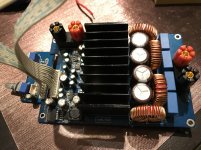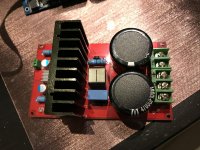I am, kind of, noob when it comes to power amps. Anyways, I bought two Class D amps. One fed with an unstable 50V power supply that fed the amp with 53V, should have been 50V so probably burned something. The question is what?

The second Amp (with two IRFB4227) was fed with +50 0 -50 but reversed..., well what can I say?
There is no obvious sign on anything burned on the circuit. Isn't there any fuse or something?
Is it possible to fix them, where do I start?

The second Amp (with two IRFB4227) was fed with +50 0 -50 but reversed..., well what can I say?
There is no obvious sign on anything burned on the circuit. Isn't there any fuse or something?

Is it possible to fix them, where do I start?
Its unlikely 53 volts would upset a 50 volt amp.
Reverse voltage will fry all/most of the semiconductors.
Reverse voltage will fry all/most of the semiconductors.
I described a procedure I use when checking if an amplifier is likely to work or not (posting 28):
TPA3116 Disaster - Boom
It is a simple test that is performed without speakers or power connected. It requires only an Ohm-meter. You may try that procedure.
For me, the procedure has worked for both class D and class AB amplifiers. If this test shows failure it is often the amplifier IC that is defect.
I recently used the procedure on three defect TPA3116 amplifiers and managed to identify the problems on all three boards. A couple of days ago I managed to mess up the supply wires to a LM1875 amplifier and the fuses, I had included in my power supply and voltage regulators, blew as intended. I used the same method of testing to verify that the amplifier (luckily) still worked.
Are you able to change the ICs if they are defect?
TPA3116 Disaster - Boom
It is a simple test that is performed without speakers or power connected. It requires only an Ohm-meter. You may try that procedure.
For me, the procedure has worked for both class D and class AB amplifiers. If this test shows failure it is often the amplifier IC that is defect.
I recently used the procedure on three defect TPA3116 amplifiers and managed to identify the problems on all three boards. A couple of days ago I managed to mess up the supply wires to a LM1875 amplifier and the fuses, I had included in my power supply and voltage regulators, blew as intended. I used the same method of testing to verify that the amplifier (luckily) still worked.
Are you able to change the ICs if they are defect?
Hmm, maybe. Thanks for the advice. I'll try your method.I described a procedure I use when checking if an amplifier is likely to work or not (posting 28):
TPA3116 Disaster - Boom
It is a simple test that is performed without speakers or power connected. It requires only an Ohm-meter. You may try that procedure.
For me, the procedure has worked for both class D and class AB amplifiers. If this test shows failure it is often the amplifier IC that is defect.
I recently used the procedure on three defect TPA3116 amplifiers and managed to identify the problems on all three boards. A couple of days ago I managed to mess up the supply wires to a LM1875 amplifier and the fuses, I had included in my power supply and voltage regulators, blew as intended. I used the same method of testing to verify that the amplifier (luckily) still worked.
Are you able to change the ICs if they are defect?
Its unlikely 53 volts would upset a 50 volt amp.
Reverse voltage will fry all/most of the semiconductors.
TAS5630 maximum supply voltage is 52.5V. Killed by a mere 500mV.
PVDD to ground is specified up to 69V, the 52.5V is the maximum voltage TI garantees th specs listed in the datasheet.
I would guess the buck ic is fried if it's not the HV version.
I would guess the buck ic is fried if it's not the HV version.
- Status
- Not open for further replies.
- Home
- Amplifiers
- Class D
- Burned Class D power amp